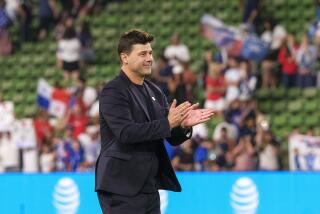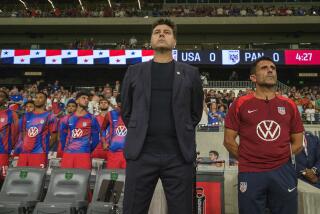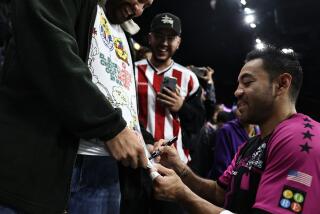America Turns Out for Sunrise Service
- Share via
The sun had yet to rise when Ursula Souders and her two children got up, pulled on their German soccer jerseys and headed for a German restaurant not far from their home. What better place to watch their beloved German team face the United States in a World Cup quarterfinal match on Friday?
Except the Loreley Restaurant in Anaheim was already crowded when they arrived at 4:20 a.m. Crowded with people rooting for the other side.
“We didn’t realize how many Americans would be here,” said Souders, a native of Wertheim, who chose seats in the back, near trophies and plaques won by a local German club soccer team.
Across the nation, Americans awoke at an uncommonly early hour to watch an uncommon spectacle. The U.S. team had reached the quarterfinal round for the first time since 1930 and, quite suddenly, soccer was important to a society that had previously dismissed it as an exercise for children and moms driving mini-vans.
They lined up in the pre-dawn darkness outside the ESPN Zone, a massive sports bar in Times Square in New York. About 4,000 of them watched on a giant screen at Robert F. Kennedy Stadium in Washington; 5,000 went to a stadium in Columbus, Ohio. Six hundred shuffled into the Arena Club at Staples Center, where they were joined by members of the Galaxy.
“I’m not surprised by those amounts of people,” said Alexi Lalas, who played for the U.S. at the 1994 and 1998 World Cups and went to Staples dressed--appropriately enough--in a bathrobe.
“There’s a soccer underground in this country that escapes every four years,” he said. “When that happens, we have a party and let the outsiders in too.”
The various soccer gatherings were as different in ambience and volume as the venues that hosted them.
In Times Square, where the game began at a more manageable 7:30 a.m., the ESPN sports bar was filled with American flags and cheers of “USA! USA!” from a partisan crowd. Ally Christianson, who played women’s soccer in college, was talking by cell phone to her roommate. He was from Germany and had gone to a nearby German bar that was so crowded, he had to watch from outside through the window.
Joel Liestman, an actor who works in a law firm, made a night of it, watching an earlier quarterfinal match before going to Times Square.
“I got up at 7 a.m. yesterday, went to work,” he said. “We went to a bar for England versus Brazil and then walked all the way up here.”
The goings-on were more stately in Washington, where, not far from RFK Stadium, the German embassy invited a select group of government officials, politicos and friends to join them at the consulate office in the posh Embassy Row district.
Bavarian rolls and danishes were served as the game was televised on a 20-foot screen. Christoph Eichhorn, an embassy attache, wore black-, red- and yellow-striped suspenders to show his support for his country’s team but, like others, tried to be sensitive to the feelings of Americans in attendance.
One German booster made a quick remark when a U.S. player received a second yellow card, which would have made him ineligible for the next match. “There won’t be a next match,” the fan said. Otherwise, Eichhorn tried his best to smooth hard feelings after Germany’s 1-0 victory.
“One thing you learn with soccer is patience,” he said. “You’ll have a great American team in the future, which is something to look forward to.”
Fans on the West Coast--three time zones away--were required to make a greater sacrifice to get out and watch the game. Connor Bohuslavizki, 9, got up at 3 a.m. so his father could paint his face red, white and blue before they went to the Loreley Restaurant and grabbed seats directly in front of the television screen.
At Staples, some attendees sported tousled hair and morning whiskers. They attempted to wash away the stupor from a short night’s sleep with juice and coffee, though some were not entirely successful judging by the conversation between two fans unhappy about the officiating of referee Hugh Dallas of Scotland, who gave five yellow cards to U.S. players.
Fan No. 1: “Where’s this ref from?”
Fan No. 2: “Dallas.”
Still, the mood was surprisingly upbeat and lively for the time of day. Fans cheered loudly. Many of them--such as Jaco Van Broekhuizen and his friends from Corona and Norco--adorned themselves in everything from face paint to dyed hair and patriotic clothing.
“Nobody thought this could happen,” Van Broekhuizen said. “We’re here to watch the upset of the century.”
His prediction did not come to pass, much to the relief of Souders, a schoolteacher who had promised to bake cookies for her students if the U.S. won.
American fans expressed disappointment, but the scene at Staples was festive enough that Lalas was prompted to call the match a success, the final result notwithstanding.
“The most important thing about this team is that it made an impact on U.S. society and culture,” he said. “The rest is gravy.”
*
This story was written by staff writer David Wharton, with reporting by staff writers Anthony McCartney in Anaheim, Lance Pugmire in Los Angeles, John J. Goldman in New York and Michelle Munn in Washington.







